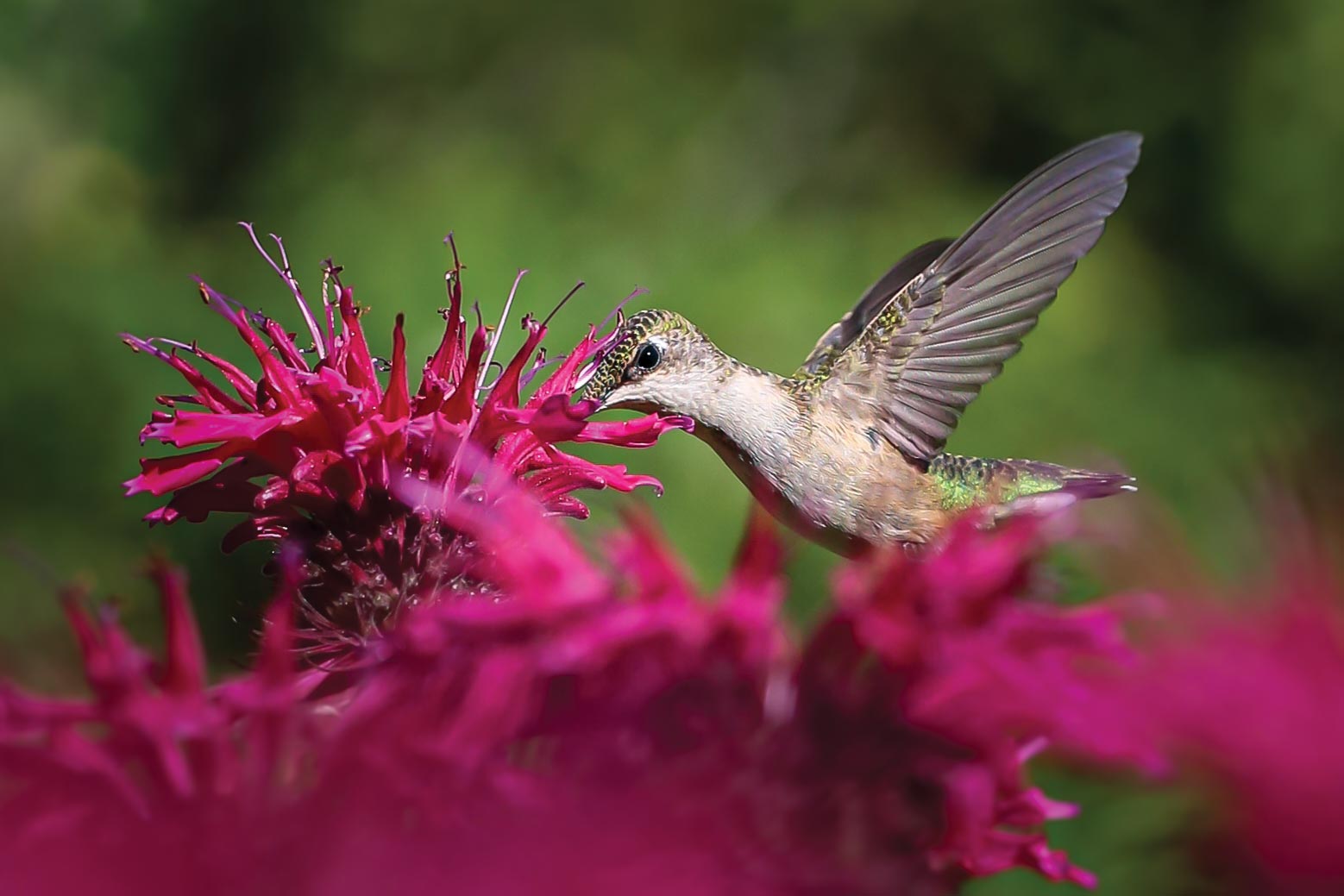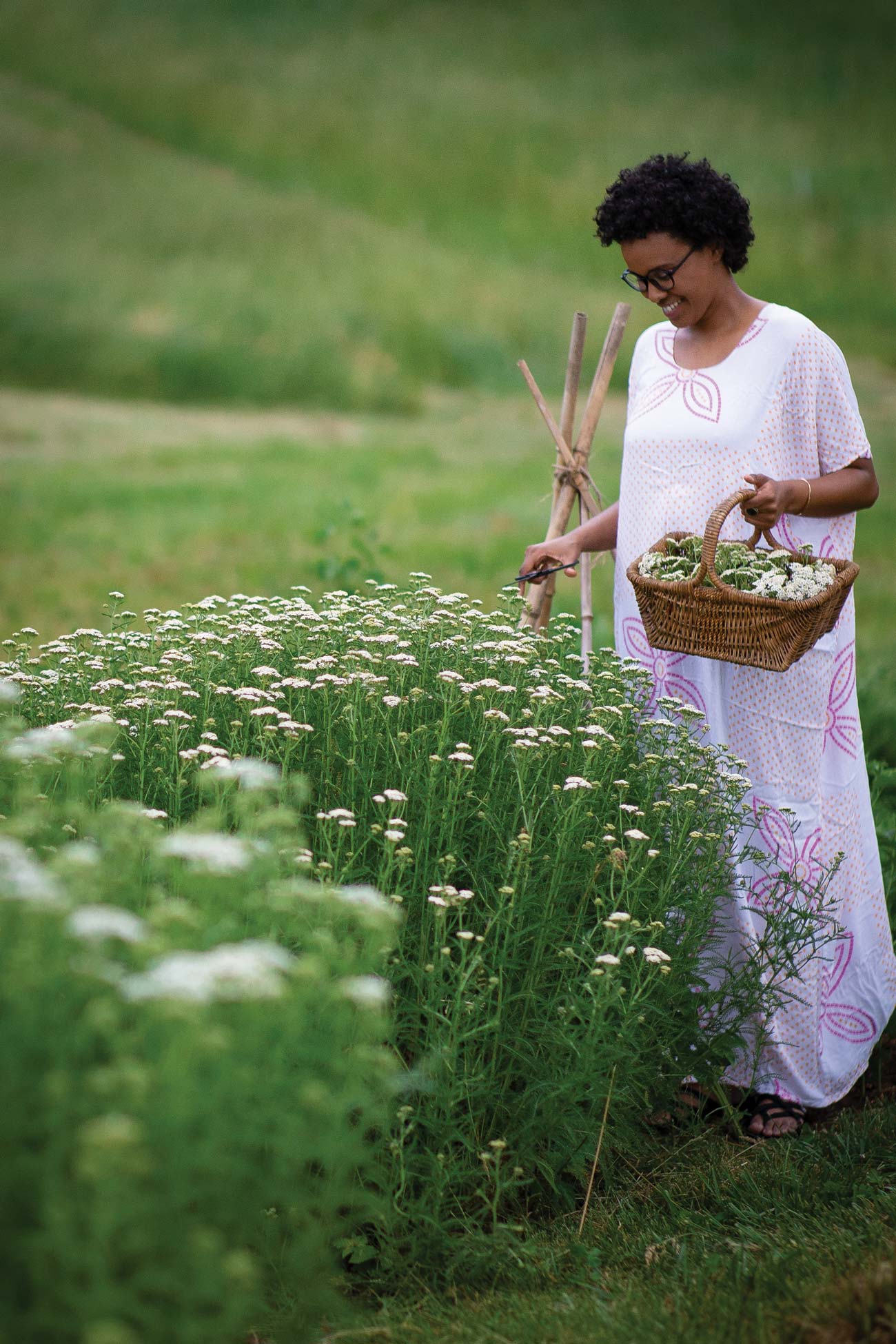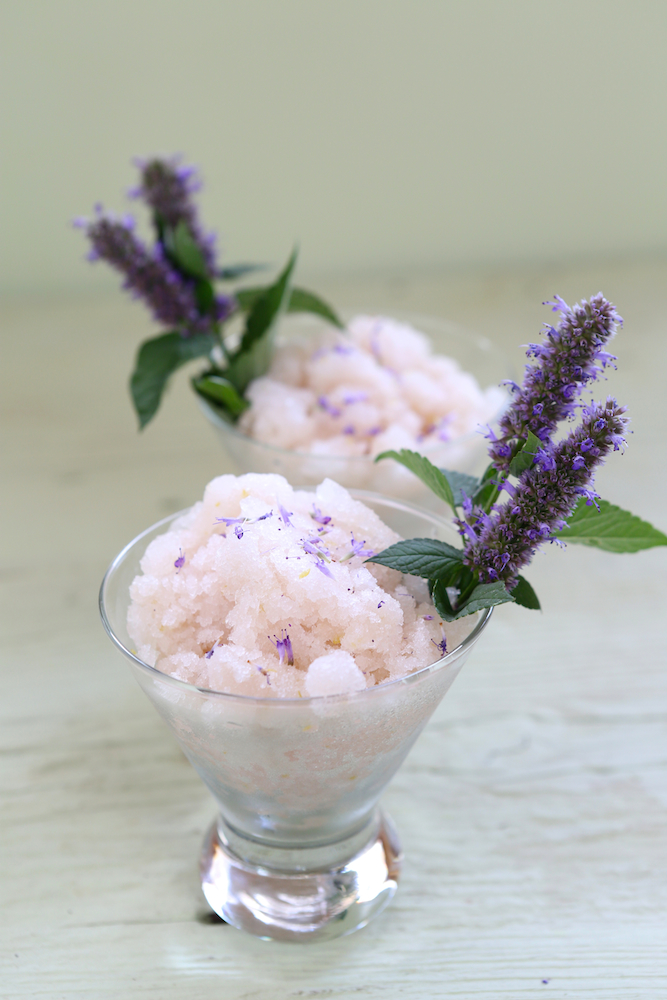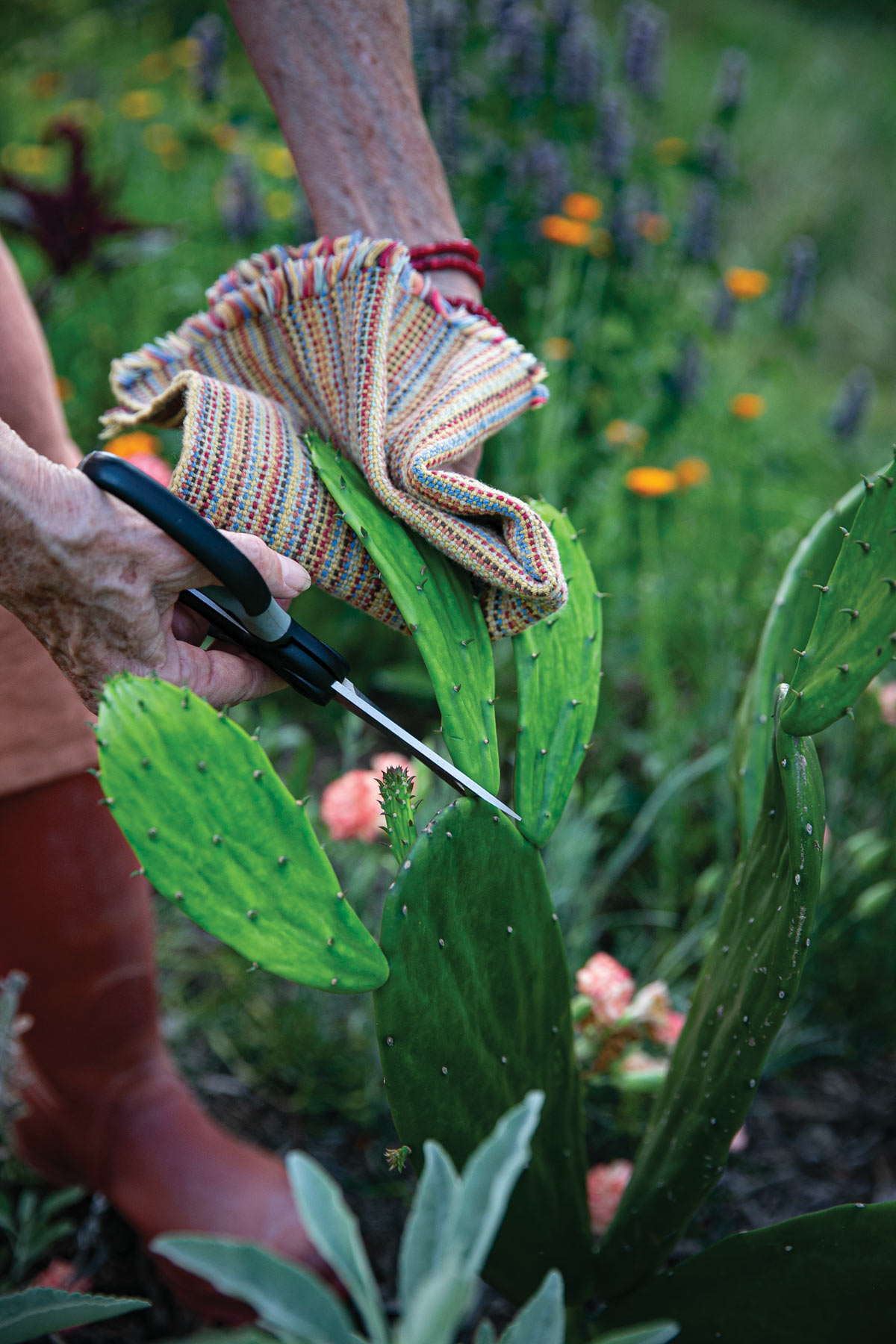FIVE EASY TO GROW HERBS FOR BEGINNERS
Photographs and text by Juliet Blankespoor with Meghan Gemma
The herb garden is a paradise of flavors, aromas, flowers, and medicine. It is a sanctuary for bees and other pollinators and a healing space for all who walk within its green borders. The cherry-red bergamot on top? Growing your own medicinal and culinary herbs brings the freshest, most flavorful plants into your kitchen and apothecary. Whether you’re planting herbs in pots on your patio or have a garden space already prepared, many medicinals will happily flourish with little fuss or coddling.
Here, we’ll explore how to grow and use five easily cultivated and remarkable herbs: spicy bee balm (Monarda spp.), whose leaves and flowers make a healing steam for respiratory infections; tongue-tingling spilanthes (Acmella oleracea), whose gumdrop-shaped flowers are packed with antimicrobial and immune-stimulating properties; wound-healing yarrow (Achillea millefolium), who is one of our premier first aid herbs; delicious anise hyssop (Agastache foeniculum), who shines in relaxing teas and tantalizing confections; and nourishing prickly pear (Opuntia spp.), whose heart-healthy pads and fruits can be prepared as tasty chutneys, juices, jams, and cocktails (or mocktails).

Bee balm (Monarda didyma) is one of the best herbs for attracting hummingbirds.
Bee Balm and Wild Bergamot
(Monarda didyma and M. fistulosa, Lamiaceae)
Parts Used: Leaves and flowers
Medicinal Preparations: Tea, tincture, honey, syrup, oxymel, steam inhalation, infused oil, and infused vinegar
Herbal Actions:
- Diaphoretic
- Antibacterial
- Antifungal
- Anticatarrhal
- Expectorant
- Carminative
- Nervine
- Antirheumatic
- Diuretic
- Emmenagogue
Medicinal Uses: All of our Western herbal understanding of bee balm and wild bergamot comes from the knowledge of Indigenous peoples (including the Cherokee, Cheyenne, Ojibwa, Choctaw, and Lakota) who use various Monarda species to assuage fevers, colds, coughs, flu, and respiratory congestion of the lungs and sinuses. I like to use the dried leaves and flowers in steam inhalations to help break up phlegm in respiratory congestion. Wild bergamot and bee balm are also used medicinally to reduce gas and bloating and improve digestion. The leaves and flowers can be added to food as a culinary herb for this purpose or ingested as a tea or an infused honey.
Cultivation: Bergamots and bee balms are some of the showiest medicinals for the garden; they lure throngs of butterflies, bees, and hummingbirds. You won’t easily find the dried herb or tincture for sale, which means to experience them as a food or medicine, you’ll need to grow your own.
Bee balm (Monarda didyma) prefers fertile, moist soil. Wild bergamot (Monarda fistulosa) thrives in hotter and drier conditions, although both will grow well in USDA temperate zones 4–8. The Monardas spread vigorously by runners. Plant them where they can go hog wild, or contain their exuberance with a rhizome barrier.
Harvest the flowering stems when they are in bloom, leaving some for the pollinators, and hang in bundles. All the Monarda species are highly susceptible to powdery mildew. If you live in an area where powdery mildew is a serious issue, you may want to harvest your Monarda in early summer, before the fungus gets hold of the leaves.
Precautions: Do not use in pregnancy. Like other spicy herbs, bee balm may aggravate heartburn.

Spilanthes (Acmella oleracea)
Spilanthes
(Acmella oleracea, Asteraceae)
Parts Used: Leaves and flowers
Medicinal Preparations: Tincture, tea, poultice, compress, tooth powder, nibble, and cocktail fancier
Herbal Actions:
- Sialagogue (salivary stimulant)
- Oral anodyne
- Immunostimulant
- Antioxidant
- Anti-inflammatory
- Antibacterial
- Antifungal
- Anthelmintic
Medicinal Uses: Spilanthes has been one of my top 10 herbal allies for the past two decades—I became a devotee the first year I began growing it and using it for medicine. One of the most common ways I use spilanthes is as an immune stimulant to augment the body’s internal defenses against the common cold and flu, especially after a potential exposure, like flying on an airplane or caring for a sick family member. Spilanthes can also be called on to stimulate immune activity throughout infectious illness, which ultimately helps a person get over the sickness more quickly.
Cultivation: Spilanthes is grown as a frost-tender annual unless you live in the tropics. Plant it in average to rich soil after the danger of frost has passed. Water during dry spells, as it relishes water more than many other medicinals. Spilanthes happily sprawls as a dense groundcover under taller herbs or vegetables, such as tomatoes, peppers, hibiscus (Hibiscus sabdariffa), basil (Ocimum basilicum), tulsi (Ocimum tenuiflorum), and calendula (Calendula officinalis). It’s possible to harvest the plants two to three times during the growing season.
Precautions: Immune-stimulating herbs like spilanthes can increase autoimmunity and have caused flare-ups in people with autoimmune conditions, although this is more the exception than the rule. As spilanthes is in the aster family (Asteraceae), it has the remote potential to cause a reaction with people who are highly sensitive to plants like ragweed and chamomile; however, there are no documented adverse allergic reactions. Take care not to squirt the tincture on the back of your throat or chew too much spilanthes at once, as the throat may take offense and clamp down.

Harvesting garden-grown yarrow (Achillea millefolium)
Yarrow
(Achillea millefolium, Asteraceae)
Parts Used: Leaf and flower
Medicinal Preparations: Infusion, tincture, poultice, powder, wash, compress, infused oil, and salve
Herbal Actions:
- Styptic
- Antihemorrhagic
- Anti-inflammatory
- Decongestant
- Astringent
- Antimicrobial
- Vulnerary
- Diaphoretic
- Circulatory stimulant
- Hypotensive
- Emmenagogue
- Antispasmodic
- Bitter
- Emetic in higher doses
Medicinal Uses: Yarrow’s flowers are a treasured remedy for colds and flu with their diaphoretic, decongestant, and antimicrobial qualities. Their antimicrobial and anti-inflammatory actions make them indispensable for clearing sinus congestion from respiratory infections. The herb offers similar relief from seasonal allergies.
Yarrow is a classic remedy for stanching the blood and is the first herb I turn to for deep cuts and excessive bleeding. It is a powerful first aid medicine due to its antimicrobial and styptic qualities. The leaves or flowers can be prepared into a concentrated tea and applied to wounds, cuts, acne, and abrasions as a wash or compress. Alternatively, yarrow can be prepared into a poultice.
Ready to dive deeper into your herbal studies?
Save 20% with code MINICOURSE20
Cultivation: Yarrow is most easily propagated through root division and can also be grown from seed. Space plants 1 foot apart and they will expand in girth annually, forming a feathery verdant mound in no time. Yarrow is a spreading groundcover that can take over if not curtailed by a semi-buried root barrier or the yearly removal of runners. It’s one of the most carefree herbs you can grow and isn’t especially fussy. The plant’s one requirement is well-drained soil, so add pine bark fines, compost, and coarse sand if your soil is clayey. Yarrow’s blooms and rich essential oil content make for a powerful companion plant in the garden.
Precautions: Because of its emmenagogue effects, avoid yarrow internally during pregnancy. Internally and externally, yarrow may cause side effects (contact dermatitis, photosensitivity, and allergic reactions) for those with Asteraceae sensitivity, although reactions are very rare. Large doses can cause nausea, dizziness, and vomiting. Be sure of your yarrow identification, as there are poisonous look-alikes.

Anise hyssop (Agastache foeniculum) harvest
Anise Hyssop
(Agastache foeniculum., Lamiaceae)
Parts Used: Flowering herb—leaves and flower spikes
Medicinal Preparations: Tea, tincture, infused honey, syrup, mead, herbal steam, elixir, homemade soda, ice cream, infused vinegar, and herbal butter
Herbal Actions:
- Nervine
- Expectorant
- Carminative
- Antiemetic
- Diaphoretic
Medicinal Uses: Anise hyssop makes a tasty beverage tea and is used as a sweetener in cooking by Native peoples of the prairie states, including the Cheyenne, Dakota, Omaha, Pawnee, and Winnebago tribes. Children have an affinity for the sweet flavor of this herb; in formulas, it can mask the more unpleasant flavors of other medicinals. It is a gentle remedy in the same league as chamomile (Matricaria recutita), linden (Tilia spp.), or mint (Mentha spp.), and is safe for most people, including children and elders.
Combine licorice mint with catnip (Nepeta cataria) and lemon balm (Melissa officinalis) in a tea or syrup, serving as a gentle remedy for coughs, fever, and colds. The herb can break up respiratory congestion as a steam inhalation along with thyme (Thymus vulgaris) and bee balm (Monarda spp.). Anise hyssop is a gentle sedative, and can be used to encourage sleep and ease headaches associated with sinus congestion. It is a traditional remedy for nausea, vomiting, and bloating.

Anise hyssop granita
Anise Hyssop Granita
Similar to Italian ice or sorbet, this slushy sweetness is a delightful way to feature the anisey flavor of anise hyssop. You can substitute other herbs for the anise hyssop; lemon balm (Melissa officinalis) and lemon verbena (Aloysia citrodora) are particularly bright possibilities.
- 3 ¾ cup water
- ¾ cup dried anise hyssop leaves and flowers (⅜ ounces, or 10.5 grams, by weight)
- ¼ cup fresh lime juice
- ½ cup sugar
- 1 Tablespoon lime zest
Yield: About 4 cups (960 ml), or 1 quart, serves 10
Bring sugar and water to a boil in a saucepan. Add the anise hyssop. Cover and let steep for 20 minutes. Strain and press out the herbal material. Combine the sweetened anise hyssop tea, lime juice, and zest. Freeze in an airtight container for 24 hours. Take out of the freezer and let thaw until you’re able to easily break up the frozen mass of goodness. Pulse in a blender until it has a slushy consistency. Then freeze again for another three to five hours, until firm but scoopable. Serve in martini cups or sorbet bowls. You can make this a few days before you plan on serving. Top with individual anise hyssop flowers or whole flower heads.
Cultivation: Sow the seeds directly on the surface of the soil and lightly tamp in. Germination occurs in one to two weeks. Roots can be divided into three or four divisions in the early spring or fall. Anise hyssop is a short-lived perennial with a lifespan of a few years. Thankfully for its fans, it prances about the garden, self-sowing freely. If you want lush licorice mint (and who doesn’t?), pinch back the growing tips every week in the spring to flesh out the plant. If you don’t encourage bushiness, the plant tends to be somewhat spindly and produces fewer blooms later in the season. Interplant the herb with other crops as a beneficial companion plant.
Precautions: None known or recorded.

Harvesting garden grown spineless prickly pear (Opuntia sp.)
Prickly Pear
(Opuntia spp., Cactaceae)
Parts Used: Pads and fruits
Medicinal Preparations: Fruit: chutney, juice, jam, syrup, lemonade, cocktails, and vinegar. Pads: slurry, capsules, juice, pickles, salsa, and poultice
Herbal Actions:
- Pads
- Demulcent
- Cholesterol-lowering
- Hypoglycemic
- Diuretic
- Vulnerary
- Fruit
- Antioxidant
- Antirheumatic
- Anti-inflammatory
- Nutritive tonic
- Cardiotonic
Medicinal Uses: The pads of prickly pear are high in soluble fiber, which helps remove excess cholesterol from the body. Studies have demonstrated the pads’ ability to lower LDL-cholesterol and triglyceride levels. Prickly pear is one of the most popular folk remedies for Type 2 diabetes in Mexico and the southwestern U.S.
The pads’ inner gloop is used throughout the world as a soothing topical remedy, much like aloe vera gel. The fruit is remarkably high in vitamin C and magnesium and also contains a fair amount of fiber.
Cultivation: There’s a prickly pear for just about any climate. Look for plants that are adapted to your region by checking with local nurseries or gardeners. Mail-order cactus companies can also be a good source. I recommend growing a spineless variety, which has obvious advantages when it comes to cultivation, harvesting, and processing. As you can imagine, the plant prefers full sun and well-drained soil. Here in North Carolina, where we have clayey soils, I grow my prickly pear in my garden’s “Mediterranean” section—an area amended with copious amounts of coarse sand.
Precautions: Use caution and consult your medical practitioner if you are taking pharmaceutical hypoglycemic agents, as prickly pear may dangerously compound blood-sugar-lowering effects. High doses of the pads may cause gastric distress—bloating and nausea—in some individuals. Some people react to raw prickly pear flesh or the juice with chills, nausea, and body aches. Start with small doses and increase slowly.
All Content, Photography, and Text, ©Juliet Blankespoor unless otherwise noted. Distribution, resale, or sharing of this material is illegal and punishable by law. Please respect the hours that went into creating this resource.
Dive deeper into your herbal studies!
Enroll in one of Chestnut School’s herbalism programs today.
Course Navigation
More Resources

